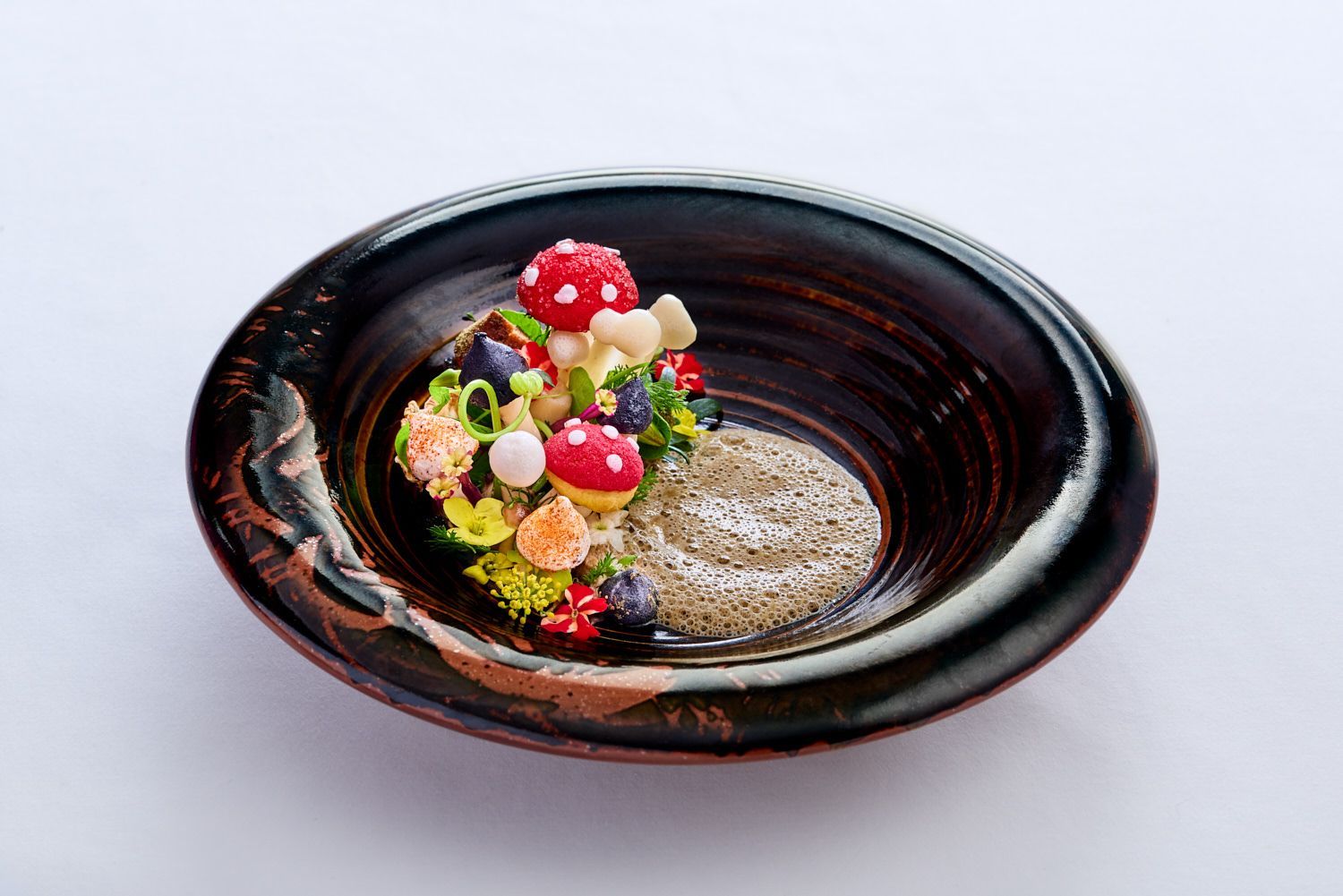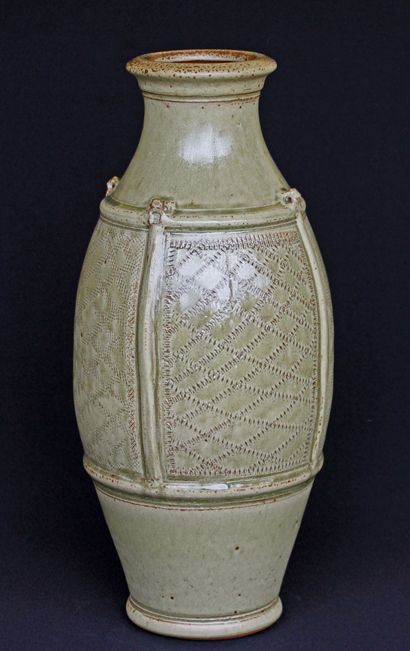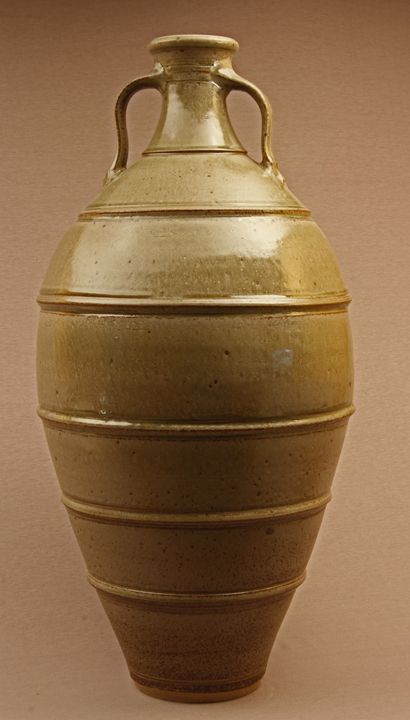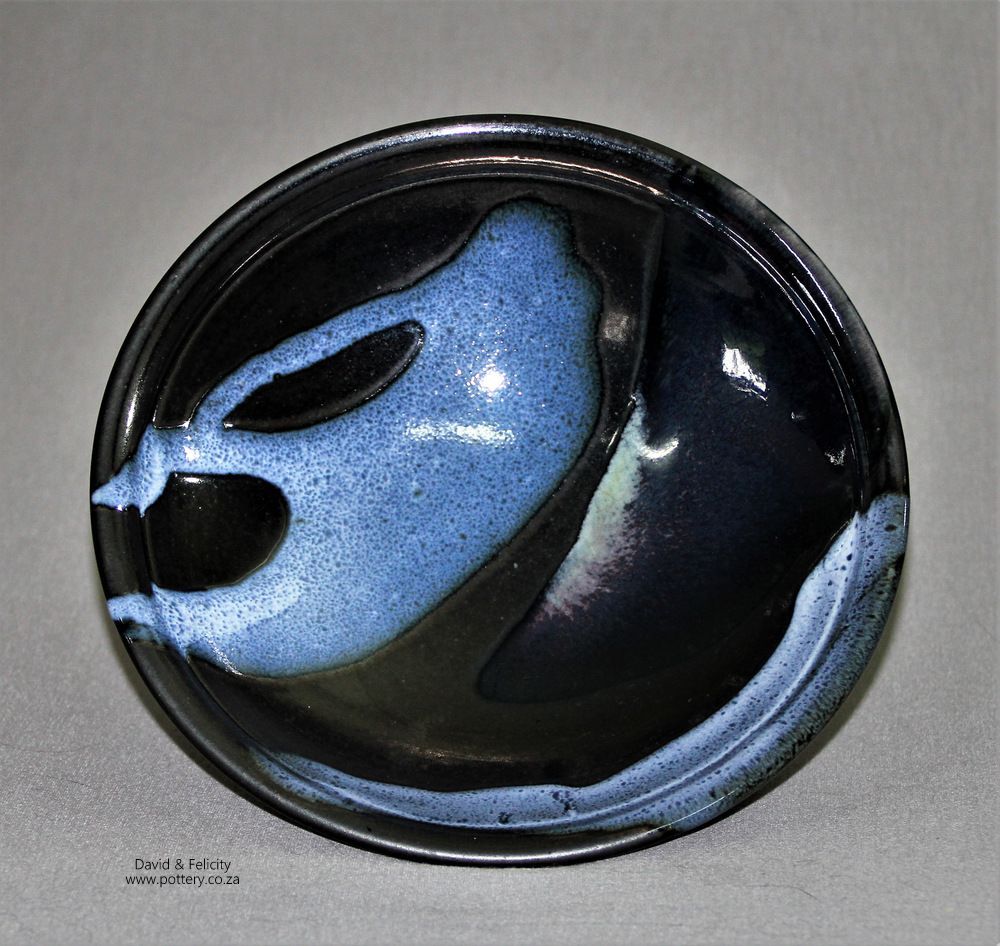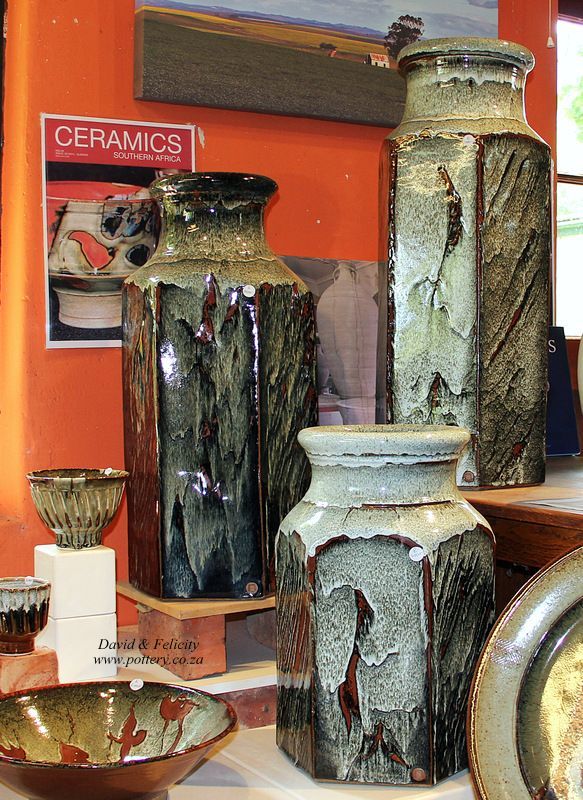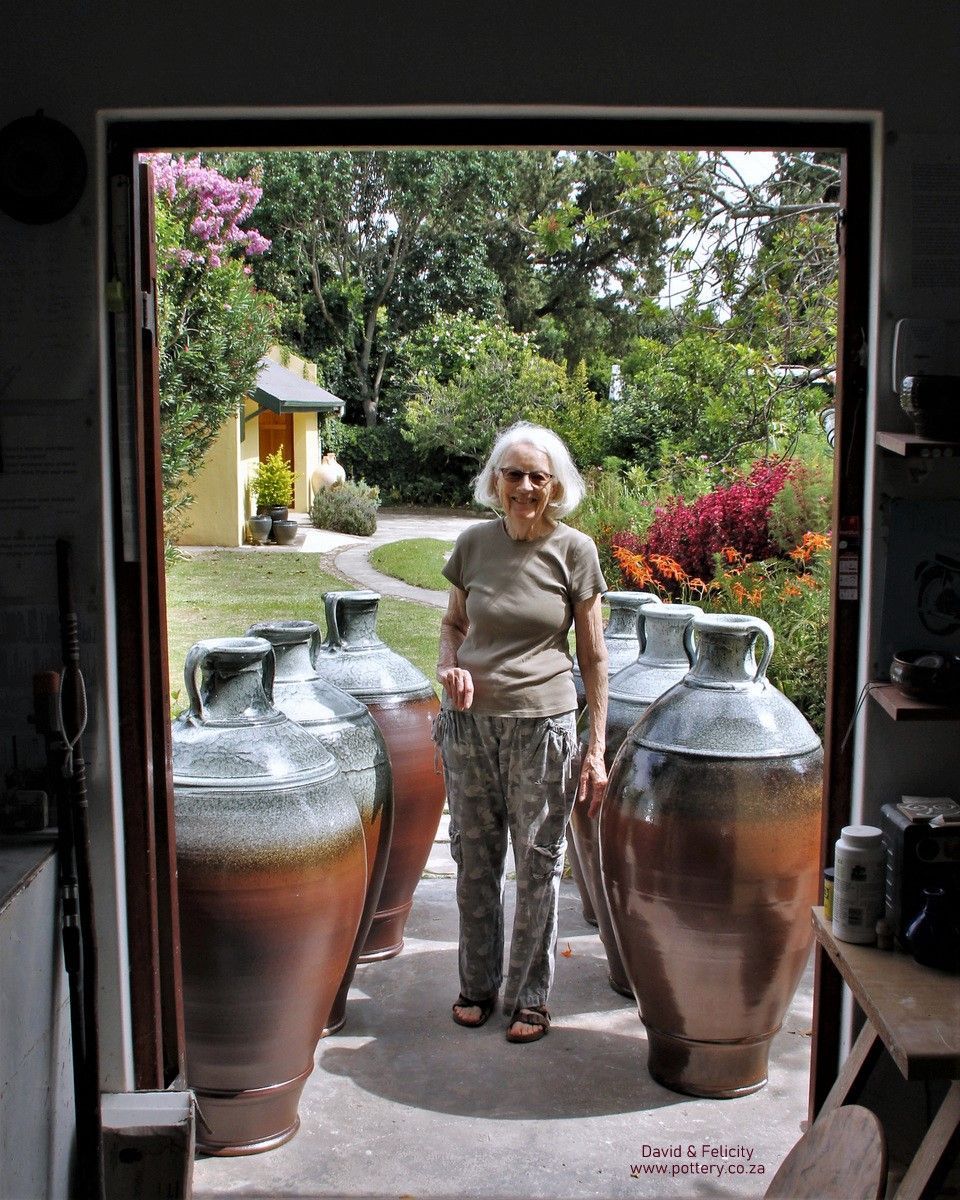
Biography:
2025:
- On 2 March, Felicity Potter passed away in Swellendam, leaving behind a profound legacy of craft, teaching, and collaboration.
- Tributes described her presence as remaining “woven into clay, garden, hearth, and studio.”
- David continues the work at Bukkenburg, honouring their shared vision through ongoing firings, commissions, and exhibitions.
- Several of their amphora and other large pots now stand in the gardens of Château des Tesnières in Brittany, France, as lasting examples of their artistry.
2024:
- Bukkenburg marked more than five decades of continuous work in Swellendam, celebrating their legacy of high-temperature reduction-fired stoneware.
- The studio continued welcoming visitors, offering workshops, commissions, and gallery sales.
2023:
- Their work gained visibility at auction: Strauss & Co, Cape Town, sold a Large Blue and White Vase by David and Felicity.
- Continued commissions and gallery exhibitions in Swellendam.
2022:
- With help from Saskia van Leeuwen, David completed a significant glaze firing in the oil kiln, re-establishing rhythm in the studio.
- New pots from this firing were displayed in the gallery and gardens.
2020–2021:
- COVID-19 lockdowns temporarily disrupted workshops and open studio weekends.
- Despite challenges, firings continued in the large oil kiln, and new works were added to the Bukkenburg gallery.
- The studio’s online presence (website and social media) became increasingly important for reaching collectors and friends.
2016–2019:
- Continued studio production, commissions, and open weekends at Bukkenburg.
- Regular glaze firings and exhibitions of new work in their gallery and gardens.
- International orders shipped abroad, keeping Bukkenburg connected with collectors worldwide.
2015:
- Featured on The Potters Cast podcast, Episode 82: “For the Love of James” (with Paul Blais).
- Cover article in Ceramics SA, Summer issue: “Bukkenburg – Zen and Now and Felicity Potter at 80” by Joy Savage.
- Ongoing open weekends, commissions, and international orders.
2014:
- Exhibition “Old Friends” at Oude Libertas Gallery, Stellenbosch, alongside a retrospective of architect and artist Hannes Meiring (Oct–Nov).
- Ceramics SA Group Exhibition, Cape Town: Anglo Oriental, Connecting Past to Present (Nov).
- Ceramics SA National Exhibition, Cape Town (Nov).
2013:
- Published in National Ceramics No 103: “Salute to a Partnership – The Synergy of Bukkenburg,” edited by Sue Whybrow.
- Exhibition at Anteros Arts Centre, Norwich, UK (Aug).
- YouTube film released: David Schlapobersky Throws Big Pots at Bukkenburg (filmed and edited by Maria le Roux).
- Commissions and orders shipped abroad, including to the USA, UK, Europe, and Australia.
- Open studio weekends and workshops in Swellendam.
2012:
- Articles in National Ceramics No 99, “Wine Jar Journey,” and in the 100th edition, “Red-hot roots” by Ronnie Watt, featuring their amphorae work.
- Continued workshops, commissions, and international orders.
2011:
- Exhibition at Gallery at RCHCC, Great Park Synagogue, Johannesburg (June).
- Workshop presenters and guest exhibitors at the Ceramics SA Clay Festival in Johannesburg (June).
2009:
- Commissioned by Hamilton Russell Vineyards to make large amphorae for maturing their wine Ashbourne Sandstone 2009.
- Feature article in National Ceramics No 87: “Bukkenburg Pottery, Gail de Klerk visits David and Felicity in Swellendam.”
- Feature article in Pottery Making Illustrated (US): “Throwing Big Pots” (May/June).
- Studio’s Facebook page launched.
- Featured in SA Country Life (Sept): “Swellendam’s Potters.”
- Published Facebook memorial pages for Tim Morris, Hyme Rabinowitz, and Esias Bosch (pioneers of high-fired studio pottery in South Africa).
- Ongoing open weekends, commissions, and workshops.
2006–2008:
- Regular studio production, commissions, and orders.
- Workshops and open studio weekends in Swellendam.
2005:
- Cover story in National Ceramics No 71 (Autumn/March).
- Exhibitions in Swellendam and Parkwood, Johannesburg.
2004:
- Launched pottery.co.za, their own studio website.
- Feature article in SA Country Life (Nov): “Not Just Pottering Around.”
- Group exhibition at William Humphreys Art Gallery, Kimberley.
- Group exhibition in Swellendam.
- Exhibition in Parkwood, Johannesburg.
2002:
- Joined Cape Overberg Meander.
- Group exhibition at William Humphreys Art Gallery, Kimberley.
2001:
- Exhibitions at Dorp Street Gallery, Stellenbosch, and in Melville, Johannesburg.
- Began construction of a large 100 cu. ft. oil-fired (kerosene) kiln.
1999–2000:
- Exhibitions: Decorex Cape at Spier, Stellenbosch; exhibition in Westcliff, Johannesburg.
- Co-founded Swellendam Alive, a major initiative for local tourism, skills training, and community development.
- Projects included:
- Reuse of Drostdy Museum space for the Old Gaol Coffee Shop, Bloukop Gallery, and Morgenzon Craft Shop.
- Reactivation of Swellendam Cultural Festival.
- Skills training programmes and craft workshops at Morgenzon House (1751).
- Partnership with Swellendam Municipality and Western Cape government.
- Awards and recognition for community impact.
- Felicity instrumental in Morgenzon House textile screen printing studio development.
- Resigned from Swellendam Alive in 2003 to refocus on pottery.
1997:
- Renovated Bukkenburg into a working pottery studio and showroom.
- First glaze firing in the 40 cu. ft. oil-fired kiln.
- First pots “Made in Swellendam.”
- Opened to the public.
- First Open Studio Weekend in Nov 1997, a tradition still ongoing.
1996:
- Moved permanently to Swellendam on 1 Oct.
- Feature in SA Garden & Home (Nov): “A Potter’s Lunch.”
- Group exhibition at Morgenzon House, Swellendam (Nov).
1995:
- Craft Council exhibition at Museum Africa, Johannesburg.
- Exhibited at Decorex Johannesburg (Aug).
- Invited to the first APSA Prestige Exhibition at Schweikert Gallery, Pretoria (Nov).
1994:
- Purchased Bukkenburg in Swellendam.
- Began teaching evening pottery classes in Johannesburg to support the bond.
1993:
- Guest exhibitors and workshop presenters for APSA.
- Group exhibition in London with the Craft Council of South Africa.
- Included in CraftArt – Focus on Clay, edited by Doreen Hemp.
- Exhibitions in Kimberley and Klerksdorp.
- Continued orders and commissions.
1992:
- Appeared in Peter Marshall’s book and TV series Around Africa.
- Assisted with Johannesburg arrangements and interviews.
- Continued orders and commissions.
1991:
- Featured in National Ceramics Quarterly No 18 (Dec).
- Included in Contemporary Ceramics in Southern Africa by Wilma Cruise and Doreen Hemp.
- Continued participation in the Johannesburg Studio Route.
1989:
- Guest exhibitors and workshop presenters for APSA.
- Founding participants of the Johannesburg Studio Route.
- Felicity design consultancy for First National Bank (with Ruth Wolff).
- Felicity textiles for Design Story, London.
1988:
- Exhibition at The Mall Gallery, London (with Coral Stephens textiles).
- Contribution to South African Potters Manual (“Making a Tea Set”).
- Felicity design consultancy for General Mining Union Corporation HQ, Johannesburg.
1980s:
- Feature article in Living magazine (1980).
- Active in township development and arts activism.
- Founding role in the Alexandra Art Centre.
- Organised Art for Alexandra exhibition at Sotheby’s Johannesburg.
- Patrons included Archbishop Desmond Tutu, Nadine Gordimer, Beyers Naudé, and others.
- Involved in numerous activist networks and cultural initiatives throughout the decade.
1979 onwards:
- First solo exhibition: Ernst de Jong Studio Gallery, Pretoria.
- Exhibited widely across South Africa, including Johannesburg, Pretoria, Kimberley, Stellenbosch, George, Durban, Cape Town, and more.
- Media features, radio/TV appearances, commissions, and architectural collaborations.
- Guest exhibitors and workshop presenters for APSA.
- Influenced by designer Ruth Wolff.
1977:
- Moved into own home and studio in Parkview, Johannesburg.
- Built first large gas kiln (town gas).
- Ongoing orders and commissions.
1976:
- Moved to Johannesburg, rented house, and began first home studio.
- First group exhibition at Helen de Leeuw Gallery, Hyde Park.
1973:
- Developed pottery studio at Cresset House for training and therapy.
- Established vegetable garden, bakery, and dairy.
- Joined APSA.
- Influenced by Tim Morris and Anglo-Oriental studio potters (Bernard Leach, Michael Cardew, Joe Finch, David Frith, Robin Hopper, John Glick, and others).
- Organised major fundraising exhibition for pottery studio equipment.
- Organised Camphill student exhibition at Sandton City.
1972:
- Moved to Cresset House, Halfway House, Johannesburg (Camphill School and Training Centre for children in need of special care).
- Became house parents to 12 young people, taught art, and assisted in classrooms.
- Invited to establish a pottery workshop, first experience on the potter’s wheel with Gordon Wales.
- Met Felicity Potter, beginning their lifelong partnership.
Exhibitions:
- The Potters Gallery
- Helen de Leeuw Gallery
- Ernst de Jong Studio Gallery
- South African Association of Arts Gallery
- Akis Gallery
- Everard Read Gallery
- Sanderling Gallery
- Quadri
- Binnehuis
- Leephy Studios
- Art Gallery 88, Sasolburg
- The Carriagehouse Gallery
- Lookout Art Gallery
- The Laura Collection
- Schweikert’s Gallery
- Gallery S
- The Mall Gallery, London – with Coral Stephens Handweaving
- Sotheby’s
- Craft Council of South Africa – Group Exhibition in London
- Museum Africa
- William Humphreys Art Gallery
- Gallery 5
- Die Blou Galery
- Dorp Street Gallery
- Strydom Gallery
- The Gallery at the Rabbi Cyril Harris Community Centre
- Rust en Vrede Gallery
- The Gallery at Grande Provence
- Oude Libertas Gallery
- Gallery at Anteros Arts Foundation, Norwich, UK



